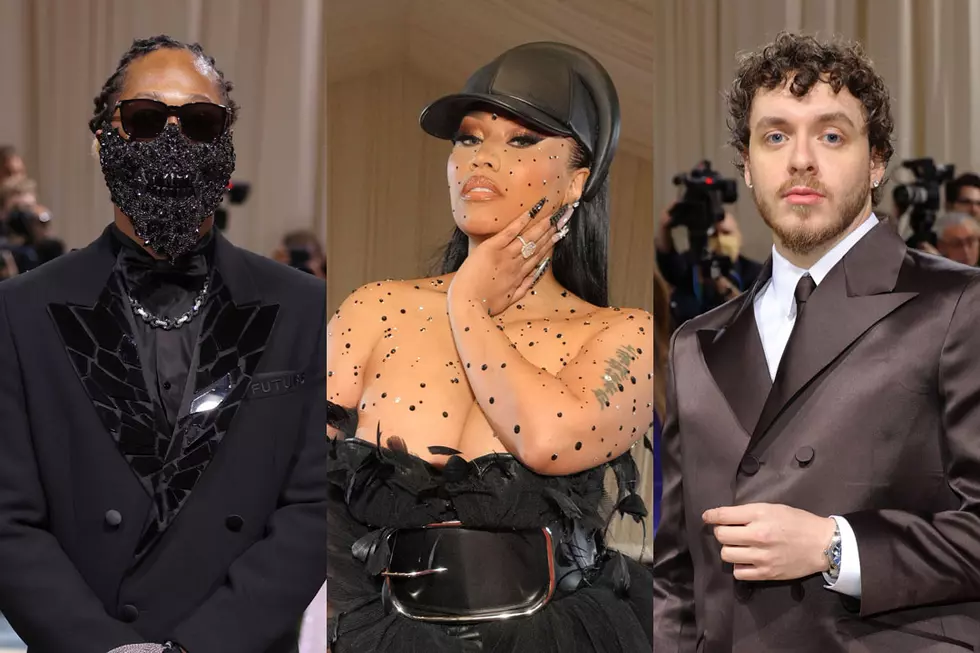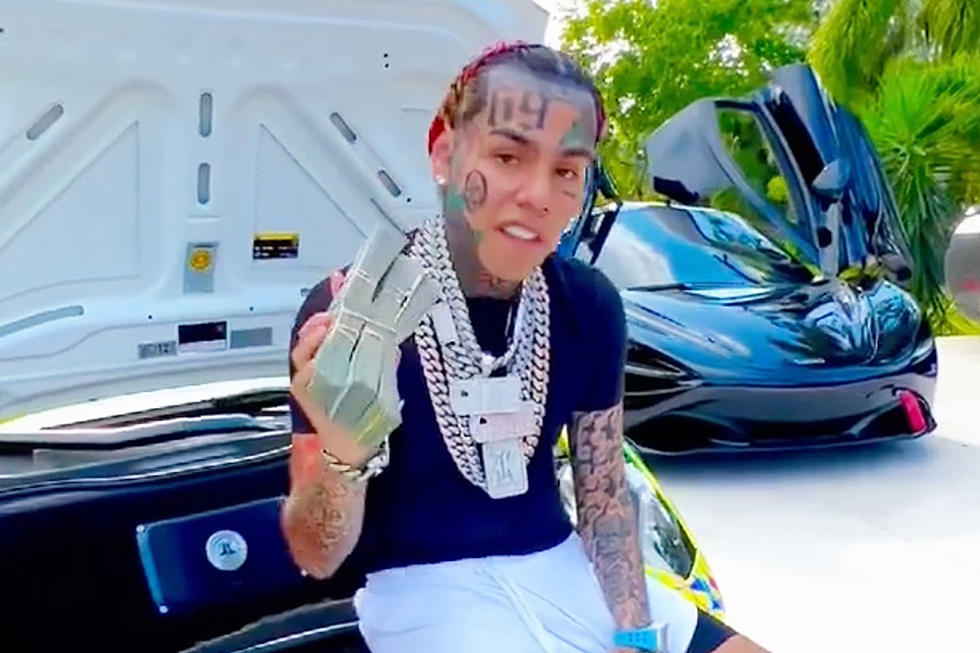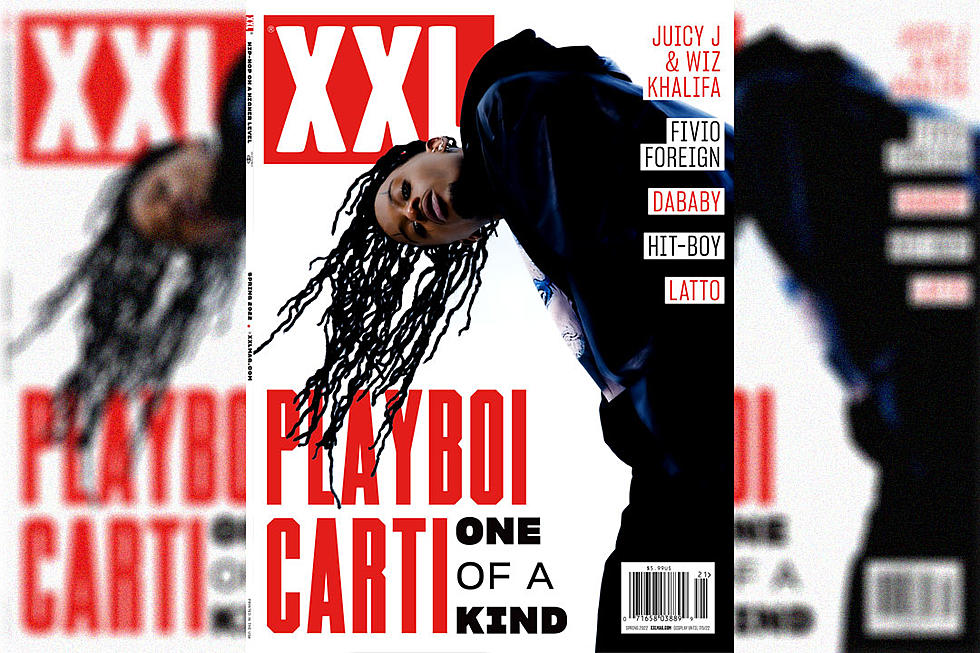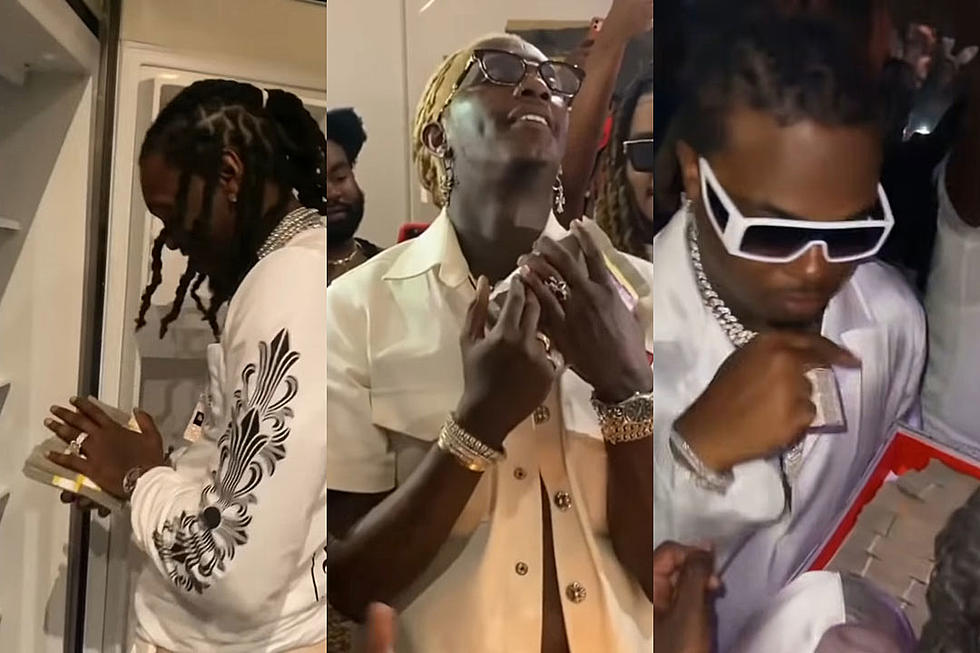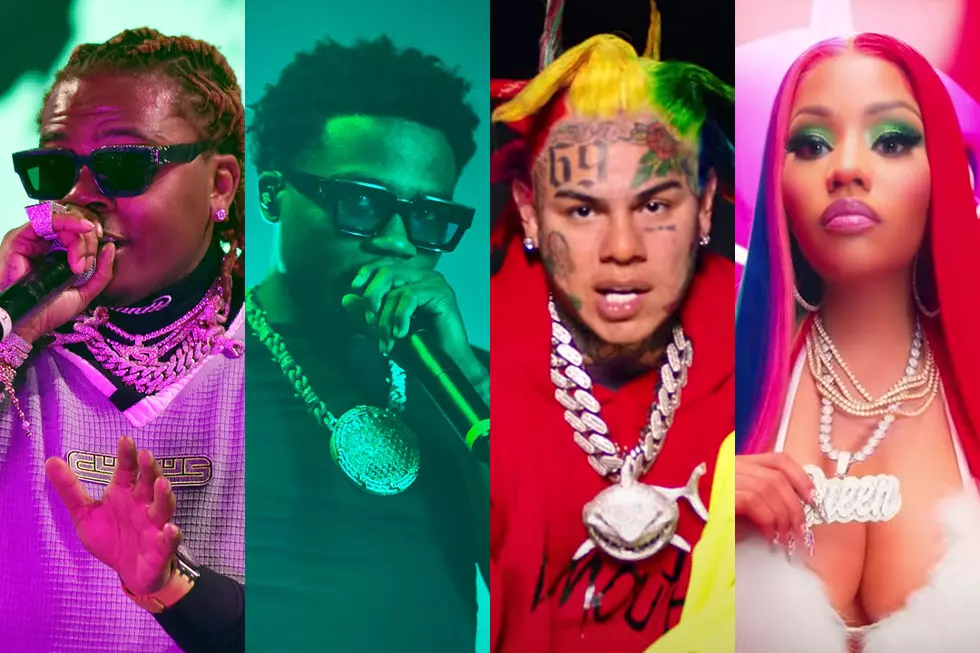
Hip-Hop’s Race to Get a No. 1 on the Billboard Charts Continues Amid a Complex System
Number One
The obsession with sitting on top of the singles chart.
Words: Sowmya Krishnamurthy
Editor’s Note: This story originally appeared in the Fall 2020 issue of XXL Magazine, on stands now.
Billboard debuted its first chart of song sales on July 27, 1940. Tommy Dorsey & his Orchestra featuring Frank Sinatra’s “I’ll Never Smile Again” took the top spot that week. Eight decades later, a much different artist than Ol’ Blue Eyes was looking at that chart—and he was heated. “So, listen, I want the world to know that Billboard is a lie,” 6ix9ine said on Instagram Live this past May 18 while addressing his nearly 23 million followers. “You can buy No. 1 on Billboard. I want that to register [in] your head. You can buy No. 1s on Billboard!” The controversial rapper was convinced streams for “Gooba,” his first single since getting out of federal prison in early April, were inaccurately counted. 6ix9ine believed that Justin Bieber and Ariana Grande had artificially inflated the sales of their joint single “Stuck With U” with CD bundles and by purchasing the track themselves. The pop stars denied wrongdoing shortly after the rapper’s accusations. Later that same day, “Stuck With U” notched the top spot on the Billboard Hot 100 chart and 6ix9ine came in third place behind Doja Cat and Nicki Minaj’s “Say So.”
More than ever, rappers are incredibly aware of their chart position. “It’s important,” says Gunna, who earned his first chart-topper with his Wunna album, also, this past May. Music consumption is up—streams topped 1 trillion for the first time last year, according to Nielsen Music—and that means it’s cutthroat for the coveted spot. “It’s getting harder and harder to stand out,” says Wendy Day of Rap Coalition. “There’s just so much competition in music.”
Even established acts that ostensibly have nothing to prove want to be on top. DJ Khaled wasn’t pleased when Father of Asahd was outsold by Tyler, The Creator’s Igor in May of 2019. “I make albums so people can play it,” Khaled said. “It’s called great music. Albums that you actually hear the songs. Not no mysterious shit.” Nicki Minaj went nuclear when Travis Scott’s Astroworld edged out Queen for No. 1 in August of 2018. She accused Scott, Spotify and the music industry as a whole for shady practices. “He knows he doesn’t have the #1 album this week,” she blasted on Twitter.
There’s the adage: Men lie, women lie, numbers don’t. Everyone wants the Billboard No. 1 but it’s not so simple. Getting the crown is more complex than straight math.
Competition is intrinsic to hip-hop and as streaming platforms like Spotify and SoundCloud replace corner cyphers and lyrical battles, the hunger to be the best remains. “Being No. 1 is important because like everyone, artists have egos,” says a major record label insider who works in streaming and wanted to remain anonymous. “Being the best strokes the ego.” Chart position is as close to objectively comparing artists as possible. “Having a No. 1 song or album is the closest we got to vanity metrics,” says Day.
Chest-beating aside, a chart-topper can land better gigs and lucrative opportunities. “There’s a direct correlation between chart and money,” says George Howard, Professor of Music Business/Management at Berklee College of Music, Founder of GH Strategic and Cofounder of TuneCore and Music Audience Exchange. “A whole host of other opportunities open up. There is a direct relationship between your chart position on the Billboard chart and your pricing for live shows, etc. So, it’s all part of the kind of overall ecosystem.” Gunna doesn’t attribute all of his success to having a No. 1 album but admits, “a lot of new deals and opportunities that I’m excited about are opening for me.”
A chart-topping artist is positioned more attractively even within the music industry; “No. 1” has a nice ring to it. Livia Tortella, Founder of Black Box and former Co-President and Chief Operating Officer of Warner Records, sees it as a powerful marketing and promotion catalyst. “You have to be super strategic,” she breaks down. “The No. 1 allows you to have a conversation with a radio programmer or it allows you to talk to a retailer and get something for it.”
“It’s extremely important to have a No. 1 hit in radio promotions,” says Kevin Holiday, SVP, Urban Promotion at Atlantic Records, who worked Roddy Ricch’s No. 1, “The Box.” “Our job and goals each day is to gain greater exposure for our artist through airplay, so once a record goes No. 1, it’s a job well done. There’s no higher mark to achieve.”
With so much competition, it’s difficult to hold onto the top spot at a stretch. Tortella advises artists to go after bigger opportunities while the iron’s hot. A No. 1 today may be forgotten by next week. “It just enables some extra opportunities for an artist, but it normally lasts one week.”
The biggest challenge in cracking Billboard is understanding the metrics behind the charts. Billboard is notoriously mum on the exact formula of streaming, sales and radio plays. Billboard was not available to comment for this story, but published this statement following 6ix9ine’s accusations: “The Hot 100 has a locked-in methodology, updated at least once a year, with each metric divided by a certain number, which results in an average chart ratio whereby streams are the most heavily weighted factor, followed next by radio airplay and then sales. Each song has its own ratio breakdown based on its specific activity, which contributes to the overall chart average each week.”
It’s a first step but doesn’t really offer full transparency. For instance, how is each metric weighted? What exactly is a stream? Many would be surprised to know that streams from TikTok and Instagram Live aren’t included. The algorithm is constantly tweaked and it’s questionable who keeps up with the nuances. In January of 2020, Billboard announced video and audio data from YouTube, along with visual plays from several streaming services, would be factored into the albums chart.
How many read the fine print that only “official licensed video content uploaded by or on behalf of rights holders” would be counted towards their albums’ streams? Comparatively, the songs chart allows user-generated content from YouTube streams to be counted. Even 6ix9ine, who watches the charts like a hawk, didn’t fully understand them. He was livid when he saw a discrepancy in his YouTube views and what Billboard reported for “Gooba.” Billboard explained that YouTube views are for global play and Billboard only looks at U.S.-based plays.
The devil’s in the details and understandably, it’s confusing.
The charts being a black box doesn’t stop artists from trying to nudge the numbers in their favor. Sometimes, it’s overt. Justin Bieber gave his fans a literal guide on how to get “Yummy” to beat Roddy Ricch’s “The Box.” In a now-deleted Instagram post, Justin encouraged fans to buy the song multiple times and to play it low while they slept. It didn’t work. Other times it’s finding a clever loophole. Lil Nas X’s “Old Town Road” made history as the longest-running No. 1 on the Billboard Hot 100 because of four official remixes. Since Billboard combines all versions of a track in tabulation, Lil Nas X essentially had four times the push.
Deluxe releases accomplish something similar. Historically, deluxe albums commemorated special moments or anniversaries. Rappers are now dropping deluxes furiously and taking advantage of the cumulative chart effect. For instance, Lil Uzi Vert’s Eternal Atake debuted at No. 1 on the Billboard 200 chart on March 15, 2020. The album received momentum (and a second week at No. 1) when the rapper added 14 songs for a deluxe version. Lil Baby’s My Turn had 20 tracks when it dropped on Feb. 28, 2020. The rapper added six more tracks as a deluxe on May 1 and charted at No. 1, twice.
Streaming takes up the lion’s share of Billboard’s methodology and optimizing for DSPs (digital streaming platforms) means longer albums (Uzi’s aforementioned deluxe album has 32 tracks) and getting on playlists. Spotify’s Rap Caviar is the biggest hip-hop playlist (13 million subscribers in June of 2020) but all DSPs have something similar: SoundCloud’s Drippin, YouTube Music’s On Everything, Tidal’s Thoro Hip-Hop and Apple Music’s Rap Life. These can be divided into editorial; playlists programmed by a human curator and algorithmic; playlists programmed by software based on listener habits and tastes or some combination thereof.
The anonymous streaming insider explains how he gets his artists on editorial playlists: “Pitch your music on time, hit marketing deadlines, have the right assets,” he says. He adds that it’s important for artists to promote their playlists on social media and add calls-to-action to increase fan engagement. Because of his relationships, he often takes artists to meet with DSPs personally to play music and to interact with the curators.
But not everyone has a direct line to the powers that be. According to Professor Howard, the game is rigged against independent artists or those without the resources or connections of major labels. He draws the parallel to payola, the illegal practice of paying a DJ or radio station to play a certain song to get on playlists. “I mean, they’re just new forms of, call it payola, in order to game the system, and those opportunities are really only available to artists that are signed to the major labels,” he says, noting that it’s a “limited number of releases getting a vastly disproportionate amount of coverage.”
One way that majors have an advantage is by leveraging one artist for another. A total hypothetical example: Republic Records offers Apple Music an exclusive track from Drake in exchange for preferred playlist placement for an emerging artist on their roster. Professor Howard explains: “They have the ability, and there’s nothing criminal about this, to say, ‘Well look, we need your DSP to give prominence to this new artist and in exchange, we will take an already prominent artist and give you an exclusive track.’”
Computers are harder to barter with but savvy artists are finding ways to hack algorithmic playlists. Tracks with a lot of streams are more likely to be picked up by the algorithm, so it’s a mad dash to get streams quickly. Automatic “bots” can generate fake traffic as can digital middlemen known as click farms. In April of 2019, NBC News’ Today went undercover into one click farm where a roomful of people were paid to monitor hundreds of cell phones that click on posts, follow accounts and watch photos. “This is really easy,” said cybersecurity expert Jim Stickley on Today. “I mean, you could train a monkey to do this. You’re paying people pennies on the dollar to perform these tasks.” Explains Professor Howard, “So, the game is to kind of trick the algorithms. You trick algorithms by getting yourself enough spins in order for the Spotify algorithm to kick in.”
In December of 2017, reporters at Vice used the now-defunct Streamify to get 10,000 streams on a track for $40. Just Google “How to Buy Spotify Streams” today and several companies claiming to juice streams for low, low prices pop up: Streambeet promises 1,000 plays for $10. Spotistar claims it can do that for only $5.
DSPs provide Billboard weekly numbers and it’s up to the individual platform to determine fraudulent behavior. YouTube responded to 6ix9ine’s allegations, denouncing number manipulation: “YouTube takes abuse of our systems, such as attempts to artificially inflate video view counts, very seriously, and take action against known abusers, including termination of their YouTube accounts.” It said its technology can “prevent the artificial inflation of a video’s view count by spam bots, malware and other means” and “the data we provide for the charts reflects this process.”
But if there’s a system in place, someone will always try to buck it. “Like with anything popular, there will be bootlegging,” laughs the anonymous streaming insider. He says that trying to pay click farms or inflating streams is moot and could get an artist banned. “It’s a waste of money and will get your account shut down so it’s really not worth it. For some reason, people think DSPs don’t fact-check the streams but they do.” Banning aside, there’s also the embarrassment—and larger career detriment—that happens when fans or insiders deem an artist a fake. Wendy Day has caught artists red-handed when their origin of streams matches locations of overseas click farms. “If I see that one of the top markets of an American rapper is Russia or Indonesia,” she says. “Or somewhere in an Eastern Bloc country? I know that they’re scamming.”
If there’s one strategy that’s universally embraced, it’s bundling. By the start of 2020, nearly every artist with a No. 1 on the Billboard 200—Kanye West and Post Malone to Taylor Swift and Billie Eilish—combined album purchases with tickets, merchandise or both. It was a win-win: Billboard counted bundles towards album purchases and fans got a bonus.
But increasingly, bundles got more random or priced so low that red flags came up. In 2012, Papa John’s sold Taylor Swift’s Red album as part of a large one-topping pizza combo. What pizza had to do with that album is debatable. Clearly, bundles were being used just to boost chart position. Nicki Minaj criticized Travis Scott for pushing merchandise and concert tickets to boost Astroworld. “What we’re not gonna do is have this fucking Auto-Tune man come up in here selling fucking sweaters and telling y’all he sold half a million fucking albums,” she said on Queen Radio.
DJ Khaled got into hot water—and lost the No. 1 spot to Tyler, The Creator—when it was discovered he bundled Father of Asahd with energy drinks. E-commerce site Shop.com reportedly told its members to buy 12 packages of the drinks to “push DJ Khaled and Market America [Shop.com’s parent company] to No. 1!” The strategy backfired. Billboard saw this as unfair practice and discounted sales through this deal. “We saw an organization encouraging purchases among their members by promising them material and organizational benefits,” Billboard President Deanna Brown explained to The New York Times in June of 2019.
Bundling got so flagrant that Billboard changed its rules. From January 2020 onward, an album sale is counted as part of a bundle if all the items in the bundle are available for purchase concurrently and individually on the same website. Merchandise sold on its own has to be priced lower than the bundle and bundles can only be sold on an artist’s official site.
[Editor's note: These new Billboard rules do not appear in the Fall 2020 issue of XXL magazine since they were instated after the print deadline.] Then in July, Billboard made a new set of rules, admitting that the previous regulations "have fallen short of the intended goal of accurately reflecting consumer intent." Under the new rules—slated to take into effect Oct. 9—all albums bundled with merchandise or concert tickets must be promoted as separate add-ons to be counted on the charts. Moreover, Billboard no longer allows sales of physical albums or singles that are bundled with digital downloads to be reported as digital sales. Only when that physical item is shipped do they count. In other words, artists can no longer offer something like signed vinyl—that won't arrive for weeks—as a way to boost first-week numbers.
New rules haven’t deterred anyone; artists are still using bundles for major releases. DaBaby bundled Blame It on Baby with beanies, hoodies and T-shirts and Lil Baby offered Dickies work shirts and pants along with his LP My Turn. Both albums hit No. 1 on Billboard’s Top 200. Justin Bieber and Ariana Grande offered signed “Stuck With U” CDs, which helped them clinch the top spot. Despite their own vociferous opposition, Nicki Minaj and 6ix9ine bundled their song “Trollz” with apparel.
The race to No. 1 isn’t going anywhere. It’s human nature to want to be the best—and to size up the rest of the pack. “Being on the top of the list will always be relevant,” says Tortella. But as DSP algorithms get smarter and new platforms like TikTok and Triller emerge, the nomenclature will change. Billboard’s monopoly on charts isn’t promised. Some artists are already looking at metrics like Instagram followers or YouTube subscribers over Billboard and in July of 2019, Rolling Stone magazine launched its own charts. Wendy Day has seen the latter garner traction, especially with independent artists: “I think that Billboard’s just going to kind of go the way of the dinosaur. I’m watching Rolling Stone give them a real run for their money.”
Regardless of what the playing field is, Tortella advises artists gunning for the top spot to be transparent. “The No. 1 currency we have with our fans is their trust,” she says. If going to No. 1 is important, be upfront with what strategies are being employed. Deception or shady practices reek of desperation and worse, can backfire if fans feel manipulated. It’s easy to get caught up in the numbers but lasting careers are made beyond release week. “You can’t build a career on bots,” says Day. “It just might be great for your ego to see a high number, but I’d rather have an artist that has 20,000 dedicated fans than a 100,000 bots.”
A No. 1 is a career milestone; it’s not a destination. “It’s never a goal,” says Tortella, who advises artists to build a holistic career. “Does it really matter in the grand scheme of things in terms of building a career? Not really.”
Play the long game.
Check out more from XXL magazine’s Fall 2020 issue including our 2020 XXL Freshman Class interviews with NLE Choppa, Polo G, Chika, Baby Keem, Mulatto, Jack Harlow, Rod Wave, Lil Tjay, Calboy, Fivio Foreign, Lil Keed and 24kGoldn, a Hip-Hop Junkie conversation with Denver Nuggets guard Jamal Murray and read one of Pop Smoke's final interviews.
See the 2020 XXL Freshman Class
More From Y105

